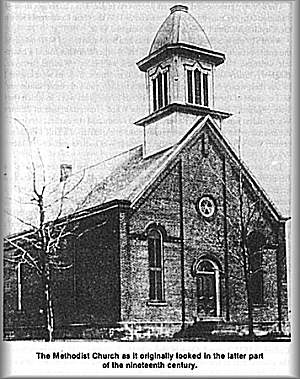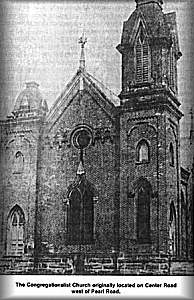|
Churches in Brunswick
The growth of Brunswick can be accurately reflected in the growth of its first church, Brunswick United Methodist Church.

The church is the oldest in the county and second oldest in the Western Reserve, founded in 1817. It began as part of a circuit - sharing one pastor with several churches. The number was narrowed to two in 1916 when the church at the center and Bennett's Corners Methodist Church shared the Reverend C. M. Gay. That arrangement lasted until 1954 when the Reverend Frank Crofoot was replaced by the Reverend Leonard Solt and the Reverend George Hickson was assigned to Bennett's Corners.
That was, of course, at the beginning of Brunswick's population boom and a well-timed move. In the mid-1970's, the town's first co-pastorate was established. Almost as soon as Brunswick had a few settlers, they began holding ecumenical services in their cabins in order to continue the worship of God in this new land.
In 1817, the Reverend Jacob Ward, a Methodist minister "of considerable influence and power," moved to the community. He cam from Pittsfield, Massachusetts, with his widowed sister, Rhoda Stowe, and her two sons John and Daniel. As soon as he arrived, he organized the first class of the Methodist Episcopal Church with 13 members. Reverend Ward worked in a large northeastern Ohio are for his church. He did the work of a home missionary going so far as making it necessary to sleep in the woods because of the distance between homes. "The roads were blazed paths and the streams without bridges. This was when the wolves, bears and rattlesnakes were dangerous," according to a booklet, "A Memoir of Jacob Ward."
The country grew so fast and many converts made. The classes got to be so numerous they required pastoral care and in 1817 the Ohio Conference set up the Cuyahoga Circuit with a preacher assigned to it.
Ward's home was the home of itinerants and headquarters of Methodism in the entire area for 22 years where ministers of other churches found a heart-felt welcome. "Here such Methodist men as Finley, Waddle, Swayze, Bieglow, Christy and McMahon, and one, if not more, bishops were enabled to rest their weary bodies and find comfort to their souls in conversation and wise counsel of these pious and gifted friends in the great work in which they were engaged," says author Edith Lurena Ward Hunt, daughter of Zelotes Ward, oldest son of Jacob. Reverend Ward conducted the earliest services of the church in the old log school house about one quarter of a mile west of the center. War Hall at Baldwin-Wallace College was built in memory of Jacob Ward.
In November 1830, John and Lucy Stearns donated a piece of land to Brunswick trustees for a burying ground, just west of the center. It was two acres of land except for a 66x88 foot plot given to the Methodist Church for a meeting house. The Reverend John Hazzard, preacher in charge of the Brunswick circuit, met November 19 with members for the purpose of appointing trustees in trust of the Methodist Church. The trustees were Fletcher Hulet, Horace Root, Darius Francis, Correll Deming, Daniel B. Stowe, Oliver Bennett, Wesley Hulet, Isaac and Jacob Ward. Donations were taken for the new wooden frame church of white clapboards with a cupola on the sloped roof, housing a church bell topped by a spire and weathervane.
In courthouse records of July 9, 1834, Thomas and Phoebe Stearns sold six acres of land to the Methodist Church for $300 for a "house of abode" for ministers and preachers, about a half mile north of Brunswick.
The Methodist parsonage was first built in 1859 on Lot 5 of the Stearns' land. In 1858, 4.82 acres of the property purchased from the Stearns had been sold to Erastus Morton. The parsonage, which had been sold to William Collier in 1872, burned down in about 1916. As early as 1867 the members of the church met at a meeting house for the purpose of talking about a new house of worship. Those members on the committee for a new site were J.C. Preston, C.G. Strong, L.H. Strong, R. Pitkin and the Reverend L.G. Gard.
On March 31, 1871, Isaac and Almeda Ward sold to the Methodist Church one and one half acres of land on the southeast corner of the circle for $1,000. The trustees were G.B. Strong, William McCauley, L. Allen, E.G. Freese, S.H. Strong, H. Crum and William Stebbins. Pastor was S. T. Dunbar. A contract with J.W. Morton for making of the bricks at $6 per thousand was entered into. The bricks to be suitable to build a house of worship were made from a clay pit at Sherman's Corners and houses made of them were much admired. The original brick structure is made with those local bricks. Contracts for mason work and woodwork and getting of material on the grounds were also made. The foundations were complete about September 1, 1871, and before winter, the house was enclosed.
A new parsonage was built adjoining the church in 1873 for Pastor A.T. Jones. In 1877, the Methodist Church sold the white church at the cemetery to the Disciple Church for $350. Thirty sheds were built near the church for horses. They were individually owned and maintained by the members. Twenty-five years later they were torn down because horses were hardly in use.
The early 1900s seemed to be a delightful time as church records showed many activities, including the Sunday School classes and their various activities and the annual Brunswick Homecoming which had as many as 500 persons in attendance.
In June 1916, the members were canvassed to raise $2,500 to remodel, repair and redecorate the church to modernize it for another generation. A new brick addition was put on the northwest corner and called the tower. The cupola which housed the bell was torn down and the bell placed in this tower. A Sunday School room was made above the vestibule and four more fashioned from the west wing of the building and the upper floor opened onto a balcony. All of the church windows were replaced with colored artglass. A week-long dedication service was held with Reverend H. Shook preaching along with the Reverends Whitehurst, Bryenton, Moss, J. Mattershead and Dr. Keyes.
In 1917 the church basement was renovated. In 1952 the outside was sandblasted and repointed and in 1955 the church redecorated. A one-acre plot of land was purchased from Corte and Pearl Carlton for future expansions for $15,000.
In 1956 the educational wing plans were made and in 1958 the cornerstone was laid after all pledges were made. A new parsonage was build at 4709 Center Road in 1959. Another expansion was made in 1976.
In the early days, members of many sects met together to worship. When meetings were held in Liverpool, the Episcopalians took the lead at the meeting. When in Brunswick, it was a Methodist of Congregationalist who led. Meetings were often held in private homes with much singing and the reading of a sermon as well as prayer.
 In 1819, a Congregational Church was instituted in the township by William Hanford and Simeon Woodruff, two missionaries. In about 1872 the Congregationalists built an elaborate structure, said to be the finest structure in the county at the time, at a cost of $25,000. However, when membership fell away, the beautiful building was dismantled. The bricks were used to build the building at the southwest corner of Brunswick Center and the windows were purchased by the Methodist Church and remain there to this day. In 1819, a Congregational Church was instituted in the township by William Hanford and Simeon Woodruff, two missionaries. In about 1872 the Congregationalists built an elaborate structure, said to be the finest structure in the county at the time, at a cost of $25,000. However, when membership fell away, the beautiful building was dismantled. The bricks were used to build the building at the southwest corner of Brunswick Center and the windows were purchased by the Methodist Church and remain there to this day.
A Society of Free Will Baptists was organized in Bennett's Corners as early as 1828 with Hiram Brooks acting as lay minister. The Disciples of Christ (now called the First Christian Church) is the oldest organization of Disciples in Median County. A group of settlers from Pompey, New York, settled on Pompey Street in Brunswick. Dr. John Clark, Brunswick physician and businessman was lay minister. In 1876, Farnum Gibbs became the pastor.
The Mount Pleasant United Brethern Church at West 130th Street at Laurel was formed in the 1870s. Norman Chidsey furnished the lumber for the church building from his farm. Reverend Baldwin and Reverend Sprinkle were two of the ministers.
Over on the other side of town, at Beebetown, a Baptist Church was organized by Elder Russell Gilmore in 1826. For eight years the members held services at their own homes. At a meeting held February 22, 1834, a committee was appointed to prepare a meeting house. The men of the neighborhood build a two-story log building in 48 days and the first service was held there on April 12, 1834.
In 1852, a frame building was erected and stood constant use for 54 years. In 1905, the church authorized John Wynn to raise a fund for repairs, but through his efforts, the community rallied and the present brick structure was erected.
In the era of 1840-45, the Bennett's Corners Community Methodist Church was established. In March 1845, the congregation purchased a plot of land on the south side of Boston Road just east of West 130th Street from George Hurd for $100. During the early years, this church shared its minister with other Methodist congregations. In 1892, the congregation decided on a larger sanctuary building and it was dedicated October 1. The church has been remodeled and enlarged several times since then, including an educational wing.
In the late 1950s, several churches were added to the growing number in Brunswick including St. Mark Lutheran Church, St. Ambrose Catholic Church, Brunswick Church of the Nazarene, Brunswick Reformed Church and Holy Trinity Lutheran Church.
Even more congregations were formed since that time including Emmanuel Baptist Temple, First Baptist Church of Brunswick, Hadcock Road Baptist Church, People's Baptist Church, Brunswick Church of God, Jehovah's Witness, Brunswick Hills Alliance Church, Covenant Community United Church of Christ, Grace Baptist Church, Free Will Missionary Church, St. Emilian Byzantine Catholic Church and St. Collette's Catholic Church.
|



